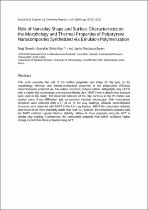 ResearchSpace
ResearchSpace
Role of nanoclay shape and surface characteristics on the morphology and thermal properties of polystyrene nanocomposites synthesized via emulsion polymerization
JavaScript is disabled for your browser. Some features of this site may not work without it.
- ResearchSpace
- →
- Research Publications/Outputs
- →
- Journal Articles
- →
- View Item
| dc.contributor.author |
Greesh, N

|
|
| dc.contributor.author |
Ray, Suprakas S

|
|
| dc.contributor.author |
Bandyopadhyay, J

|
|
| dc.date.accessioned | 2014-02-19T07:55:21Z | |
| dc.date.available | 2014-02-19T07:55:21Z | |
| dc.date.issued | 2013-10 | |
| dc.identifier.citation | Greesh, N. Ray, S.S. and Bandyopadhyay, J. 2013. Role of nanoclay shape and surface characteristics on the morphology and thermal properties of polystyrene nanocomposites synthesized via emulsion polymerization. Industrial & Engineering Chemistry Research, vol. 52(46), pp 16220-16231 | en_US |
| dc.identifier.issn | 0888-5885 | |
| dc.identifier.uri | http://pubs.acs.org/doi/ipdf/10.1021/ie4024929 | |
| dc.identifier.uri | http://hdl.handle.net/10204/7230 | |
| dc.description | Copyright: 2013 ACS Publications. This is an ABSTRACT ONLY. The definitive version is published in Industrial & Engineering Chemistry Research, vol. 52(46), pp 16220-16231 | en_US |
| dc.description.abstract | This work evaluates the role of the surface properties and shape of clay type on the morphology, thermal, and thermo-mechanical properties of the polystyrene (PS)/clay nanocomposites prepared via free-radical emulsion polymerization. Attapulgite clay (ATT) with a needle-like morphology and montmorillonite clay (MMT) with a platelet-like structure were used in this study. The dispersed behavior of the clay particles in the PS matrix was studied using X-ray diffraction and transmission electron microscopy. Only intercalated structures were obtained with ATT at all of the clay loadings, whereas semiexfoliated structures were observed with MMT in the low clay loading. All of the composites obtained were found to be more thermally stable than neat PS. However, the composites prepared with the MMT exhibited greater thermal stability relative to those prepared using the ATT at similar clay loading. Furthermore, the composites prepared with MMT exhibited higher storage moduli than those prepared using ATT. | en_US |
| dc.language.iso | en | en_US |
| dc.publisher | ACS Publications | en_US |
| dc.relation.ispartofseries | Workflow;12144 | |
| dc.subject | Nanocomposites | en_US |
| dc.subject | Attapulgite clay | en_US |
| dc.subject | ATT | en_US |
| dc.subject | Montmorillonite clay | en_US |
| dc.subject | Morphology clay | en_US |
| dc.title | Role of nanoclay shape and surface characteristics on the morphology and thermal properties of polystyrene nanocomposites synthesized via emulsion polymerization | en_US |
| dc.type | Article | en_US |
| dc.identifier.apacitation | Greesh, N., Ray, S. S., & Bandyopadhyay, J. (2013). Role of nanoclay shape and surface characteristics on the morphology and thermal properties of polystyrene nanocomposites synthesized via emulsion polymerization. http://hdl.handle.net/10204/7230 | en_ZA |
| dc.identifier.chicagocitation | Greesh, N, Suprakas S Ray, and J Bandyopadhyay "Role of nanoclay shape and surface characteristics on the morphology and thermal properties of polystyrene nanocomposites synthesized via emulsion polymerization." (2013) http://hdl.handle.net/10204/7230 | en_ZA |
| dc.identifier.vancouvercitation | Greesh N, Ray SS, Bandyopadhyay J. Role of nanoclay shape and surface characteristics on the morphology and thermal properties of polystyrene nanocomposites synthesized via emulsion polymerization. 2013; http://hdl.handle.net/10204/7230. | en_ZA |
| dc.identifier.ris | TY - Article AU - Greesh, N AU - Ray, Suprakas S AU - Bandyopadhyay, J AB - This work evaluates the role of the surface properties and shape of clay type on the morphology, thermal, and thermo-mechanical properties of the polystyrene (PS)/clay nanocomposites prepared via free-radical emulsion polymerization. Attapulgite clay (ATT) with a needle-like morphology and montmorillonite clay (MMT) with a platelet-like structure were used in this study. The dispersed behavior of the clay particles in the PS matrix was studied using X-ray diffraction and transmission electron microscopy. Only intercalated structures were obtained with ATT at all of the clay loadings, whereas semiexfoliated structures were observed with MMT in the low clay loading. All of the composites obtained were found to be more thermally stable than neat PS. However, the composites prepared with the MMT exhibited greater thermal stability relative to those prepared using the ATT at similar clay loading. Furthermore, the composites prepared with MMT exhibited higher storage moduli than those prepared using ATT. DA - 2013-10 DB - ResearchSpace DP - CSIR KW - Nanocomposites KW - Attapulgite clay KW - ATT KW - Montmorillonite clay KW - Morphology clay LK - https://researchspace.csir.co.za PY - 2013 SM - 0888-5885 T1 - Role of nanoclay shape and surface characteristics on the morphology and thermal properties of polystyrene nanocomposites synthesized via emulsion polymerization TI - Role of nanoclay shape and surface characteristics on the morphology and thermal properties of polystyrene nanocomposites synthesized via emulsion polymerization UR - http://hdl.handle.net/10204/7230 ER - | en_ZA |





